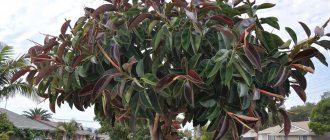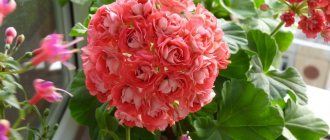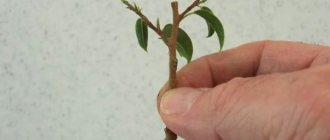Variegated forms of ornamental crops are among the most popular. They are distinguished by the original coloring of the plates, which sometimes attracts attention no less than the flowers. Among Ficus benjamina varieties, variegation is not uncommon. One of the most popular is ficus Starlight. Its medium height allows it to be grown in a large office or small apartment, and the wide white border on the leaves prevents it from getting lost among other indoor flowers.
How to choose in a store
You can buy ficus Starlight, which is considered one of the most ornamental plants, at any flower shop. When choosing, you should carefully examine the crown to purchase a strong bush.
Its condition can be determined by the following qualities:
- a healthy specimen has fresh leaves, without black, yellow or red spots on the surface;
- shoots are flexible, do not contain breaks, cracks, growths and rot;
- the buds are green and elastic.
When purchasing, shake off the crown; if the leaves do not fall off, the flower is healthy and can be purchased. The average price for a seedling is from 400 to 500 rubles.
Photo
In the photo Benjamin's ficus "Starlight":
Varieties of Ficus Benjamin such as Baroque, Golden King, Natasha, Kinky, Variegated, Daniel, Mix and Anastasia will fit perfectly into the interior of a home or office. You can get acquainted with the features of their cultivation in special materials on our portal.
Description of ficus
Starlight is a variegated plant of the Mulberry family, a variety of Benjamin.
The description includes several distinctive qualities:
- leaves are small, green - 5 cm long, contain whitish spots in a chaotic pattern, some specimens are completely white;
- the edges of the leaf blade are slightly wavy, with a matte surface;
- the branches are flexible, drooping, and tolerate pruning well;
In the wild, the plant is huge - reaches 5 m in height, at home it is no more than 1.2 m, and grows slowly - the annual growth is 5-10 cm. The lifespan of an indoor specimen is 15-20 years.
In addition to decorative qualities, ficus has many other advantages:
- cleans the indoor air of toxic substances, formaldehyde, benzene, phenol, saturates it with oxygen;
- has a beneficial effect on the nervous system - calms and pacifies.
The flower is considered poisonous, especially for animals and children, so it should be kept out of reach. If it comes into contact with the skin, the milky sap may cause an allergic reaction. When caring for it, you must wear rubber gloves.
Benefits and harms
The plant secretes milky sap when cut , so contact with it is not recommended for people who are allergic to latex.
It is advisable to keep away from children and pets.
Despite this, ficus has a beneficial effect on the environment indoors.
It purifies the air from hazardous substances such as formaldehyde, phenol and benzene.
Contemplation of a beautiful tree also has a beneficial effect on your emotional state.
It can be placed in meditation rooms, living room and bedroom.
Growing conditions
To grow a beautiful and healthy bush at home, the seedling should be provided with all the necessary conditions for growth and development.
Temperature
Optimum temperature in the spring-summer period: during the day 23-25°C, at night it drops to 18-19°C. This difference ensures health and full growth of green mass.
In winter and autumn, lower values are required: up to 16-20°C during the day and 12°C at night.
The flower does not react well to drafts, so when ventilating the room, especially in winter, it must be taken to another room. Otherwise, the leaves on the ficus will turn yellow and fall off.
Importance
Ficus loves high air humidity - 75-80%. To ensure this condition in spring and summer, it is sprayed with warm boiled water every other day.
Additionally, place an open container of water in the room or place the flowerpot on a tray with wet pebbles or expanded clay.
In winter, it is advisable to keep the flower away from heating devices - they significantly dry out the air, which leads to massive shedding of foliage.
Lighting
This plant with variegated foliage needs good and diffused lighting. With a lack of light, its leaves become pale and monochromatic.
It should be placed on the western or southwestern side of the house with the possibility of shading at lunchtime.
The optimal duration of a day is 10 hours. In winter, this condition is ensured by artificial lighting lamps.
Location and lighting
Benjamin flower is a light-loving plant. But it is advisable to place bushes with monochromatic dark leaves in partial shade, and those with light leaves under diffused natural light. But ficus with variegated leaves containing chlorophyll will not be able to fully produce the sugar it needs without bright sunlight. So such plants should be placed in bright places.
The most successful location for a Benjamin flower would be a wide window sill facing southeast, or a place somewhere near a window facing south. The north side is suitable only for ficuses with dark leaves, and then only in summer. There is almost always a lot of light on southern windowsills, but too bright rays can burn the thin leaves of the plant. So don't forget to keep an eye on his comfort.
And remember: the correctly chosen permanent location of the flower is the basic rule of good care. Ficus Benjamin quickly gets used to the daily routine and a certain place, adjusting to the optimal metabolic rate. That is why he finds it difficult to tolerate any changes.
The plant needs direct sunlight in the mornings, before 10-11, and in the evenings, after 17. But only mature bushes can withstand midday rays, and even then, not all species. So a light curtain or blinds on the window will definitely benefit the ficus. In cold seasons, it is best to place flowers close to sunlight. At this time, the ficus needs lighting, otherwise its leaves will crumble and lose their beautiful color.
Green varieties tolerate shade much more easily, but they also cannot do without light for too long - over time, their growth will slow down, the crown will become ugly, and the stems will turn pale. If you do not have the opportunity to place a flowerpot with a ficus closer to the window, provide it with good artificial lighting, for example, install a fluorescent lamp.
Be sure to keep in mind that the Benjamin plant hates drafts. This is a huge stress for him, because of which he may lose his leaves.
So be careful when ventilating your room, especially during cold seasons. The proximity of air conditioners, fans and batteries will also not benefit the ficus
Replanting after purchase
The purchased flower should be replanted
The transplant is carried out three weeks after purchase. First, the flower is quarantined to make sure it is completely healthy, then the procedure begins.
Use a container slightly larger than the size of the root system; you can take a plastic or ceramic pot with drainage holes at the bottom.
Stages:
- the plant is spilled with plenty of water to facilitate the process of extracting the roots and to avoid injury to them;
- Usually, replanting is carried out by transferring an earthen clod, then the voids are filled with fresh substrate - a mixture of peat, humus and sand;
- Afterwards, the ficus is watered and placed in a warm place with good lighting.
Transplantation is necessary not only for purchased flowers, but also for home flowers in the following cases:
- if the plant has become cramped in the old container and its roots are visible through the drainage holes;
- due to damage to roots by rot, parasites and fungal infections;
- It is recommended to replant young flowers every year; adults from 5 years of age do not bother - they only replace the surface soil with fresh and more fertile one.
Signs and superstitions
Fans of mystical teachings give ficus special properties. It is believed to promote conception. Particular importance is attached to the donor. A flower obtained from a successful married couple in this regard works better.
It is also recommended to keep ficus in the office of any manager. It helps direct your thoughts in the right direction and focus on the main points.
Indoor ficus Starlight is a very spectacular plant. It will be appropriate in both residential premises and offices. In addition, Starlight is also a wonderful air purifier. If you create an optimal maintenance regime, there will be no problems with it.
Rules of care
Caring for the Starlight ficus is simple and even a novice gardener can do it. If you follow all the rules of agricultural technology, you can grow not only a beautiful plant, but also one that is resistant to diseases and pests.
Watering
To moisten this flower, use settled or filtered water at room temperature. Prefers moderate watering, because from excess moisture the roots quickly begin to rot.
The scheme is as follows: during the growing season - twice a week, in the cold season - every ten days.
Additionally, on the second day after moistening, surface loosening of the soil is carried out to maintain its moisture and breathability properties.
Feeding
As food, they take ready-made mineral and organic fertilizers for ficuses, which are applied alternately every two weeks throughout the entire growing season - from spring to autumn.
Many people use natural fertilizers - in spring and summer they use preparations with a high nitrogen content. This component stimulates the growth of green mass.
Flower growers use several means - an infusion of manure (1:10), chicken droppings (1:20), a solution of wood ash (1:5) or green fertilizer from nettles (a bucket of raw materials is filled with 5 liters of water).
Crown formation
Basic flower care includes regular pruning. Starting from the age of three years, the ficus Starlight undergoes anti-aging pruning and, along with it, the formation of the crown. This is usually done in early spring before the buds begin to bloom.
For cutting, take sharp and sterile scissors, cut off all the branches growing inward, at the wrong angle, broken off, shriveled and damaged by disease.
If desired, you can create a dense spherical shape by pinching out the apical shoot. This will stimulate the growth of lateral processes.
After this procedure, the plant can be sprayed with Epin solution so that it recovers faster.
How does Ficus Starlight reproduce?
Methods of reproduction and features of their implementation at home.
Germination of seeds
The process of growing ficus from seeds:
- Fill the container with ficus soil.
- Water the soil.
- Sow the seeds and cover them with plastic.
- Place it on the window. The main thing is that the place is not dark.
- Once a day, remove the polyethylene for 10 minutes to ventilate the soil.
When the first sprouts appear, remove the bag. The seedlings can be transplanted to a permanent place after the appearance of several full-fledged leaves.
Rooting cuttings
The most popular method is cuttings. How to root cuttings:
- Choose long large branches, at least 10 cm long.
- Tear off the lower leaves.
- Trim the underside of the cutting at a 45 degree angle.
- Place the cuttings in the Kornevin root stimulator for 1 hour.
- At this time, you can prepare the soil.
- Plant the cutting in the ground and cover it with a glass cover.
- Water generously with filtered water.
Every day the cap is removed for 20 minutes to ventilate the soil. In a few weeks the first roots should appear. After this, the cuttings are transplanted to a permanent place.
Air layering
How to propagate a plant by layering:
- Select a section on the side stem. Tear off all the leaves from it.
- Make two circular cuts at a distance of 3-5 cm.
- Remove the bark from this area.
- Place wet sphagnum moss on the bag and secure.
After a few months, roots should appear under the cut. After this, you can cut the branch and plant it in the ground.
Other options
There are no other methods of reproduction.
Reproduction
Very easy to transplant
The best method of flower propagation is using stem cuttings. During spring pruning, shoots are cut off from the apical branches. The optimal length of planting material is 12-15 cm. Before planting, they are immersed for an hour in a root formation stimulator - Heteroauxin or Kornevin. Then they are lowered into water so that the buds are on the surface.
For quick rooting, it is worth creating greenhouse conditions - cover with transparent film or half a plastic bottle.
After about 10-14 days, the cuttings will produce roots, after which they can be planted in small pots with a diameter of 10 cm and always with drainage holes. A nutrient substrate made of river sand, peat and turf (1:1:2) is suitable for planting.
Young plantings are shed with warm water and placed in a warm and well-lit place, but with protection from the scorching sun.
The optimal temperature is 25-26°C, humidity is 80%.
Trimming
The optimal time for pruning shrubs is spring. Description of the cutting process:
- As soon as the plant has grown to a length of 50 cm, cut off the top of the trunk by 10-15 cm.
- As soon as the side branches have grown longer than the main stem, they are shortened.
- If the weaving of branches is dense, some of the thinnest branches are cut off.
Important! For pruning, you can only use sharp pruning shears that do not leave creases. The cut areas are sprinkled with crushed charcoal.
Diseases and pests
- If the rules of maintenance and cultivation are violated, this flower becomes weak and is often damaged by various infections and insects:
- Spider mites envelop leaves, internodes, and buds with cobwebs. It sucks the juices out of them, as a result of which the affected areas turn brown and die. To combat it, acaricides are used - Actellik or Aktaru.
- Shield. It attaches itself to stems and leaves and feeds on their juice. The drug Decis will help to exterminate it - the crown and the soil under it are irrigated twice with an interval of 7 days.
- Aphid. It reproduces at a rapid pace and can destroy the entire tree in a short period of time. Both adults and young individuals love to feast on the juice of young organs. Karbofos or Fundazol will help get rid of it. Severely affected flowers are sprayed 2 times at intervals of a week.
- Nematode. The white worm eats young roots; if detected in a timely manner, the ficus can be saved. It is removed from the pot, all sore spots are cut off, then the roots are washed under running water and dipped in any fungicide for two hours. After drying, transplant into a new container with a sterile substrate.
- Root rot. Typically, such a fungal infection develops due to frequent waterlogging of the soil. At an advanced stage, the plant is disposed of. Weakly affected flowers are removed from the pot, the rotten areas are cut off to healthy tissue, then they are powdered with charcoal and irrigated with a solution of copper sulfate. Replant into a new pot with fresh soil.
- Anthracnose. With this disease, the leaves become covered with brown spots, and later ulcers form at the sites of infection. Treatment is carried out using fungicides.
For prevention, it is worth buying healthy flowers, planting or replanting them in a sterile soil mixture. It is also important to regularly inspect for damage by diseases and pests and promptly remove damaged areas and treat with appropriate medications.
In addition to this, it is necessary to wash the crown twice a month with a soap solution, covering the substrate. This will prevent the invasion of harmful insects.
Features of agricultural technology
No matter how healthy the ficus Starlight plant is, its care must be correct. Variegated varieties lose their decorative properties faster and are more demanding on maintenance conditions than those with smoothly colored leaves.
After the purchase
Ficus is quarantined for 2 weeks separately from other flowers, carefully observed for pests or diseases. In the store, insects or external signs of microorganism activity may simply be washed off rather than treated with pesticides.
Then they determine whether the ficus needs a transplant. When Starlight grows in peat, in spring or summer it must be moved to a new pot and fresh soil. If the plant was purchased before or during the dormant period, it is better to wait until at least mid-February.
In this case, you will have to take care of the ficus especially carefully - transport peat dries out quickly, and, when over-moistened, it tends to retain water in the center of the coma for a long time.
The Starlight variety, regardless of the season, must be replanted immediately in the following cases:
- the root rots;
- the ground smells bad;
- the soil has bunched up into a tight lump and does not allow air or water to pass through;
- the pot is completely occupied by tangled ficus roots, there is almost no soil.
Temperature and lighting
Variegated varieties, including Starlight, are more demanding of heat and light. They cannot be placed on a south window without protection in the form of a light curtain, but direct rays at any time except for a few midday hours will not harm the plant.
Partial shade will not affect the health of the ficus, but the white areas of the leaves will become smaller or turn light green. To restore variegation, it is enough to bring the pot closer to the light source or place a lamp nearby.
In summer, Starlight can withstand temperatures of 27-30° C well, but in winter it should not fall below 15° C. At 12° C, some of the leaves will fall off and the decorative appearance will suffer.
In the warm season, the variety can be placed outside, but only in a place protected from wind, drafts, and direct sunlight. Starlight should not be placed next to heating devices in winter, or in front of an air conditioner, open window or balcony door in summer.
Humidity and watering
Benjamina is the most demanding of the ficus plants when it comes to air humidity. The crown should be sprayed with warm soft water every day, and more often in hot weather. The exception is cool wintering at a temperature of about 15° C.
Starlight needs to be watered regularly, but in moderation; both drying out and soaking of the soil will have negative consequences. In the first case, there is a high probability of root rotting, in the second - leaf fall.
The need for watering is checked by immersing the index finger along the first phalanx or a wooden stick into the substrate. It must dry:
- 2-3 cm for potted plants;
- tub specimens – 5 cm.
Feeding
For normal development, Ficus Benjamin Starlight needs to be fertilized regularly:
- during active growing season they are carried out every 14 days;
- during the transition period (March and October) and during warm wintering - once a month;
- from November to February, fertilizing is not applied if the room is cool.
Excess fertilizer will not make Starlight grow better, but it can create problems. Excess nitrogen is especially dangerous:
- plant tissues become loose;
- the likelihood of the occurrence and development of putrefactive processes increases;
- leaves that have lost turgor are easier to bite or pierce for pests;
- the width of the white border decreases.
Microelements are better absorbed with foliar feeding.
Errors during cultivation
Many gardeners, especially beginners, make mistakes in caring for and growing plants, which leads to the loss of its decorative properties and death.
- Irrigation system failure. Due to excess moisture, the roots rot, and due to lack of moisture, the above-ground part dries out and the ficus begins to fall. Therefore, you need to water moderately and regularly.
- Do not overuse fertilizers - exceeding the dosage and frequency of their application has a negative impact on health and appearance. Follow all rules and regulations for the use of fertilizers indicated on the package or bottle.
- Keeping it in the dark causes the leaves to turn pale and fall off. This phenomenon is also possible with a lack of light in winter. Provide plants with 10 hours of light with protection from the scorching sun.
- Avoid drafts, as this can lead to wilting and death of the flower.
general information
If you see a beautiful evergreen ficus in the house, it is probably Ficus Benjamin, because it is the most popular in our latitudes. In warm countries and islands, it lives in the wild and grows up to 20 m. On all sides, the huge plant produces aerial roots, which become additional support. Even at home, ficus Benjamin easily grows to the ceiling, so it is better to trim and shape it. Leathery leaves can be plain or spotted. They are relatively small, as for a ficus - up to 10 cm, but there are a lot of them. Several cuttings are planted in one flowerpot at once, which are then intertwined into one large and beautiful plant.
How to distinguish from other varieties
Twilight and Starlight are very similar to each other: they have the same height and crown shape. But they have one difference - the color of the leaves.
The first leaves are the same green, but the whitish tint is contained only at the edges. In addition, this variety does not have completely white leaves, like Starlight.
It is also easy to confuse with the De Gantelle variety: the color of the leaves, the height and shape of the crown are the same.
But this plant has larger leaves than Starlight’s - the size can reach 7-8 cm. In addition, the number of solid green leaves is predominant - about 80% of the total mass.
When and how does it bloom
Ficus Kinki - description and care at home
Under natural conditions, ficus Starlight blooms, but almost never at home. There is no particular beauty in its buds. The flowering itself does not depend on the season.
Types of flowers
Ficus flowers do not conform to generally accepted ideas. It's more like peas. Starlight's are red or bright red. They are called syconia. The diameter of each is no more than 2 cm. The inside of the balls is hollow, at the top there is a hole for pollination by insects.
Flowering period
The appearance of syconia does not depend on the season. They can be seen all year round.
Changes in care during the flowering period
If by some miracle syconia appear on a home flower, then caring for the plant becomes more complicated. No deviations in temperature, humidity, or fertilization parameters should be allowed. But experts strongly advise picking off the inflorescences. They still won’t produce seeds (no pollination), but they will draw the plant’s strength onto itself. The flower may even die.
Species diversity of domestic ficus
Common types of ficus among gardeners are considered to be:
- Kinki (is a low, lush bush, the leaves are small, with a light edge);
- Natasha (thin short stems of this species lend themselves well to twisting, the foliage has a rich green color with white veins);
- Starlight (the foliage is almost white, from a distance it seems that the plant is covered with snow);
- Curli (the leaves of this species are twisted in a spiral, because it is not for nothing that “curli” in translation means “curly”).
All of the listed types of Ficus Benjamin are far from the only ones, but only some of the most common.
This home flower is completely unpretentious, so even novice gardeners can grow it at home and in offices without any problems. Pots with different types of Benjamin can simultaneously decorate both a small room and a winter garden of impressive size. Ficus trees acquire particular sophistication and originality thanks to the ability to shape the crown at their own discretion and braid pliable trunks in the most unusual way, creating hedges from them.
But, along with the described positive capabilities of this universal plant, it is worth mentioning such an unpleasant but common problem as dropping leaves. The answer to the question of why the ficus sheds its leaves can be answered in only one phrase - improper care. If your plant shed no more than 10-12 leaves during the autumn-winter period, then there is no point in worrying. The fact is that this is a natural process of foliage renewal. In the spring, new young leaves will certainly grow to replace the discarded leaves. But if about 50 leaves fall simultaneously in a short period (several days), you should be wary and look for the cause of the plant disease, including those caused by improper care.
Land requirements
For full growth, a fertile soil mixture is necessary; ideally, it should have the following properties:
- a suitable acidity level not exceeding pH = 6.5-7;
- breathability;
- content of vitamins and micronutrients.
Important! The concentration of nutrients in the soil must correspond to the norm, since an excess of potassium, nitrogen and phosphorus leads to a weakening of the plant’s immunity, as well as deformation of its shoots and leaf blades.
Stagnation of moisture in the soil is detrimental to indoor ficuses; this can be avoided using a drainage system. A high drainage layer will ensure good circulation of air and water near the root system.
Young specimens need a loose mixture containing the following components:
- humus;
- turf land;
- peat;
- sand.
Turf should be taken from areas where perennial grasses grow; its combination with humus allows you to obtain a nutritional composition. Peat and sand will promote the passage of water and air. You can also use the following as leavening agents:
- charcoal;
- coarse sand;
- or expanded clay.
Their presence in the soil will prevent stagnation of moisture, leading to rotting of the root system.
Adult ficuses require denser soil with the following composition:
- sand;
- humus;
- leaf soil.
Important! To grow ficus plants, it is unacceptable to use soil with a clay structure.
If the acidity level is below pH 6.5-7, lime or dolomite flour should be added to the soil, and if it increases, peat should be added.











